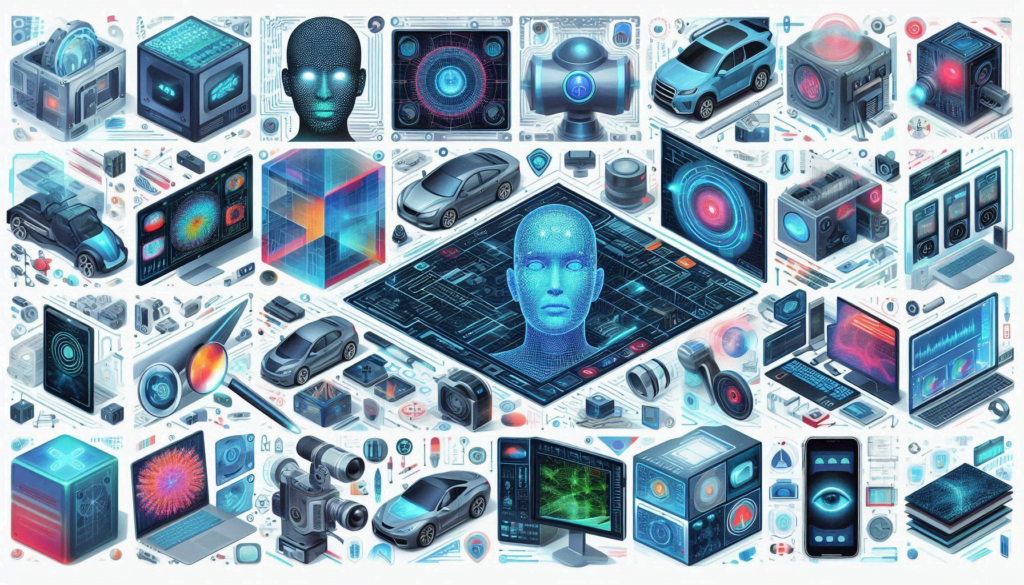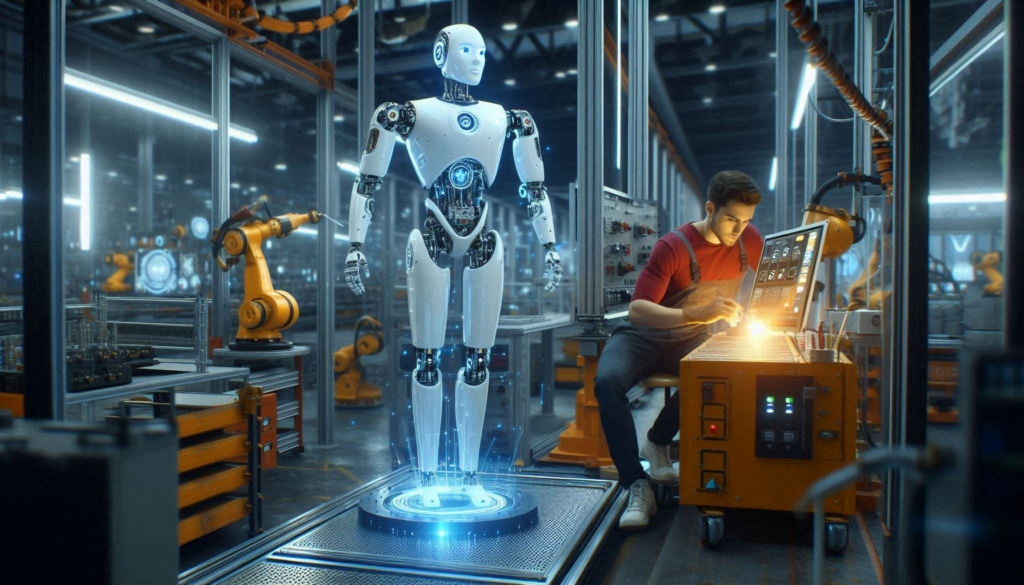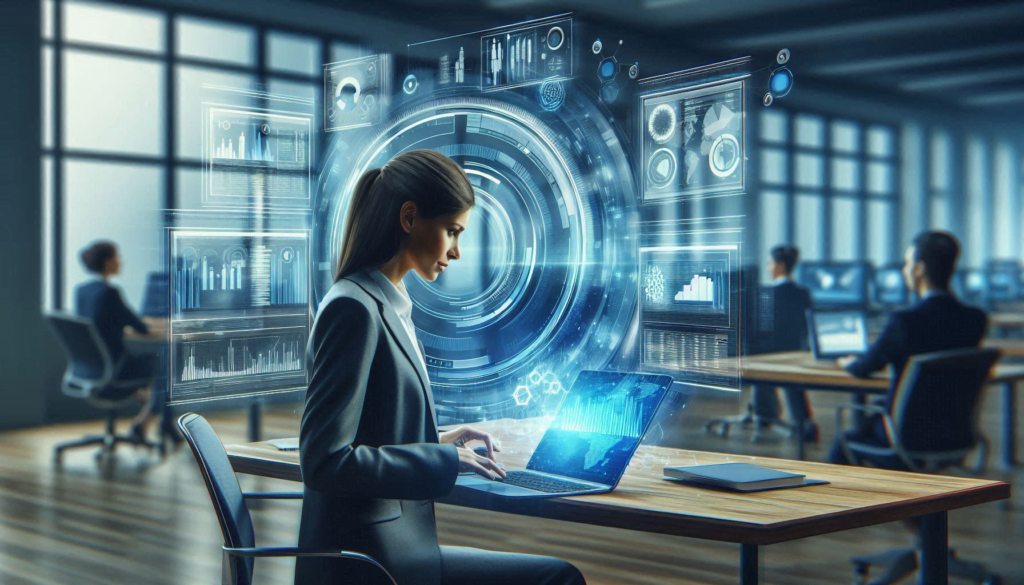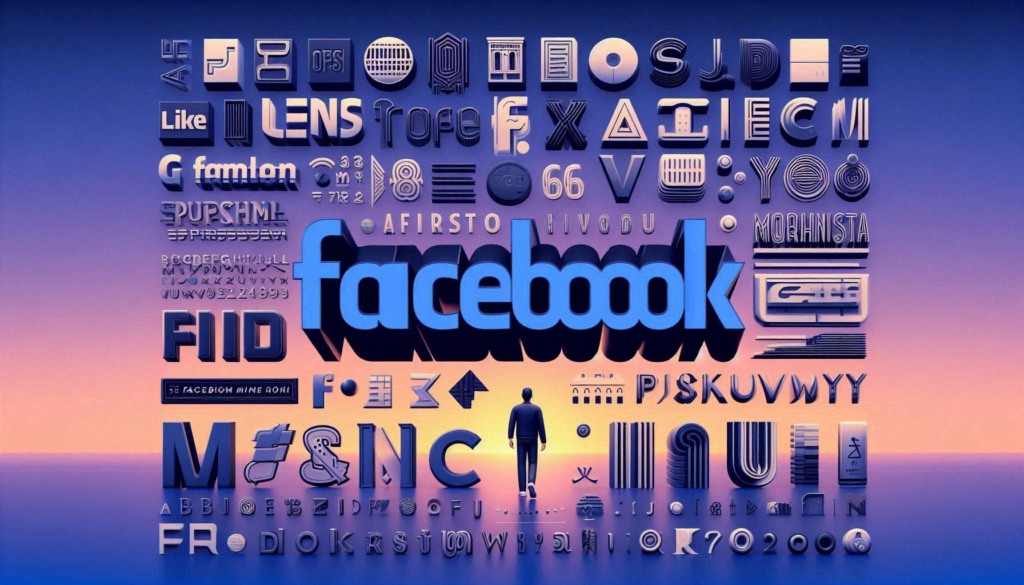Welcome to Technology Moment, where we explore the cutting-edge innovations shaping our world. Today, we’re diving into the transformative realm of Computer Vision—a field that’s revolutionizing how machines interpret and interact with visual data. Imagine a world where computers can not only see but understand and respond to their surroundings with human-like perception. That’s the promise of computer vision.
From self-driving cars navigating city streets to medical systems diagnosing diseases with unprecedented accuracy, computer vision is making remarkable strides. It blends artificial intelligence and machine learning to give machines the power to analyze images and videos, offering insights that were once the realm of science fiction.
In this blog post, we’ll explore the fundamentals of computer vision, trace its evolution, and uncover the diverse applications that are reshaping industries. Join us as we delve into how this technology is influencing our daily lives and what the future holds. Buckle up—technology is about to get a lot more visionary!
What is Computer Vision?
The branch of artificial intelligence (AI) known as computer vision gives machines the ability to see, interpret, and comprehend images. Through the use of deep learning models and digital images from cameras and movies, robots are able to precisely recognize and classify objects, and then respond to what they “see.” In essence, a computer vision is about teaching machines to see and make sense of visual data in a way that is similar to human vision.
Imagine a world where machines can recognize your face, detect objects in real-time, or even navigate through traffic autonomously. This is all made possible through computer vision, which plays a crucial role in developing intelligent systems that can interact with their surroundings more effectively.
Computer Vision’s Significance in the Modern World
The importance of computer vision cannot be overstated, as it underpins a wide range of applications that are increasingly becoming part of our daily lives. From facial recognition systems used in smartphones to medical imaging that assists doctors in diagnosing diseases, computer vision is revolutionizing the way we interact with technology.
In industries such as automotive, healthcare, retail, and security, computer vision is transforming processes and driving innovation. For instance, in the automotive industry, computer vision is a key component in the development of self-driving cars, enabling them to perceive their environment, recognize traffic signs, and avoid obstacles. In healthcare, computer vision is used to analyze medical images, aiding in early detection and treatment of diseases.
Moreover, as AI and machine learning continue to advance, the capabilities of computer vision are expanding. The ability to process and analyze vast amounts of visual data in real-time is opening up new possibilities, making computer vision an essential technology for the future.
Table of Contents
The Evolution of Computer Vision
Computer Vision, a field that enables machines to interpret and make decisions based on visual data, has undergone significant evolution since its inception. This journey from concept to a vital technology spans decades, marked by numerous breakthroughs and technological advancements. Let’s dive into the evolution of computer vision, tracing its origins and exploring the key milestones that have shaped this transformative field.
Historical Background
The roots of computer vision can be traced back to the 1950s and 1960s, a time when the idea of enabling machines to “see” was more science fiction than reality. Early work in the field was primarily focused on simple image processing tasks, such as edge detection and pattern recognition. Researchers were interested in how computers could be taught to recognize basic shapes and patterns in images, which laid the groundwork for more advanced techniques.
One of the first major developments in computer vision was the introduction of optical character recognition (OCR) in the 1950s. OCR technology, which allowed computers to recognize and interpret printed text, was an early example of machines processing visual information. Although primitive by today’s standards, OCR was a significant step towards the development of more sophisticated computer vision systems.
Key Milestones in the Development of Computer Vision
The evolution of computer vision can be divided into several key phases, each marked by significant advancements:
- The 1970s: Early Research and Foundations
- During the 1970s, computer vision began to emerge as a distinct field of study. Researchers focused on understanding how machines could interpret visual information in a manner similar to human vision. The development of algorithms for edge detection, segmentation, and texture analysis during this period laid the foundation for future advancements.
- The 1980s: Feature-Based Methods
- The 1980s saw the rise of feature-based methods in computer vision. These methods involved identifying specific features within an image, such as edges, corners, and textures, and using them to recognize objects or patterns. This decade also witnessed the introduction of the first machine learning techniques in computer vision, allowing systems to learn from visual data and improve over time.
- The 1990s: The Advent of Machine Learning
- The 1990s marked a significant turning point in the evolution of computer vision with the integration of machine learning techniques. Researchers began to explore the use of neural networks, particularly convolutional neural networks (CNNs), to improve the accuracy and efficiency of image recognition tasks. This period also saw the development of more advanced algorithms for object detection and tracking.
- The 2000s: The Rise of Deep Learning
- With the introduction of deep learning in the 2000s, computer vision underwent a revolution. Deep learning, a subset of machine learning, involves training neural networks with multiple layers to automatically extract features from images. The introduction of large datasets, such as ImageNet, and the increase in computational power allowed deep learning models to achieve unprecedented levels of accuracy in tasks like image classification, object detection, and image generation.
- The 2010s: Computer Vision in the Age of AI
- In the 2010s, computer vision became increasingly intertwined with artificial intelligence (AI). The combination of deep learning, big data, and powerful GPUs led to significant advancements in real-time image processing and video analysis. Computer vision applications expanded beyond academic research into industries such as healthcare, automotive, retail, and security. Self-driving cars, facial recognition systems, and medical imaging solutions became practical realities.
- The 2020s and Beyond: The Future of Computer Vision
- As we move into the 2020s, the evolution of computer vision continues to accelerate. Advances in AI, particularly in areas like generative adversarial networks (GANs) and reinforcement learning, are pushing the boundaries of what is possible with visual data. The integration of computer vision with the Internet of Things (IoT) and 5G technology is opening up new possibilities for real-time, edge-based processing in applications ranging from smart cities to autonomous drones.
How Computer Vision Works
Computer Vision is an intricate field that enables machines to interpret and make decisions based on visual data, much like how humans use their eyes and brains to see and understand the world. To grasp how computer vision works, it’s important to break down its fundamental components and processes.

Basic Principles of Computer Vision
At its core, computer vision involves the processing and analysis of images or video data to extract meaningful information. This process can be divided into several key stages:
- Image Acquisition:
- The first step in computer vision is capturing an image or a sequence of images. This can be done using cameras, sensors, or other imaging devices. The quality and resolution of the image are crucial, as they directly impact the accuracy and effectiveness of the subsequent steps.
- Image Preprocessing:
- Once an image is acquired, it often needs to be processed to enhance its quality. This step may include tasks such as noise reduction, contrast enhancement, and normalization. Preprocessing helps to improve the clarity of the image, making it easier for the computer to analyze.
- Feature Extraction:
- In this step, the computer identifies and extracts key features from the image, such as edges, corners, textures, and shapes. These features are essential for distinguishing different objects within the image. For example, in facial recognition systems, features like the distance between the eyes, the shape of the nose, and the contour of the lips are extracted to identify individuals.
- Object Detection and Recognition:
- After extracting features, the next step is to detect and recognize objects within the image. This involves comparing the extracted features with a database of known objects or patterns. For instance, in a self-driving car, the system must recognize traffic signs, pedestrians, and other vehicles by matching the detected features with pre-existing models.
- Image Segmentation:
- Image segmentation is the process of dividing an image into multiple segments or regions, each representing a specific object or part of the object. This step is critical for isolating the object of interest from the background, making it easier to analyze and interpret.
- Interpretation and Analysis:
- Once objects are detected and segmented, the computer must interpret and analyze the visual information. This could involve determining the object’s position, orientation, size, or even predicting its future movement. The analysis is often context-dependent, meaning that the computer must consider the environment and surrounding objects to make accurate decisions.
The Role of Algorithms in Computer Vision
Algorithms are the driving force behind computer vision. These are sets of rules or instructions that the computer follows to process visual data. Some of the most commonly used algorithms in computer vision include:
- Convolutional Neural Networks (CNNs): These deep learning algorithms are particularly effective for image recognition and classification tasks. CNNs consist of multiple layers that automatically learn to detect and recognize patterns in images, making them ideal for tasks like object detection and facial recognition.
- Support Vector Machines (SVMs): SVMs are used for classification tasks, where the goal is to separate data into different categories. In computer vision, SVMs can be used to classify images or detect specific objects within an image.
- Optical Flow: This algorithm is used to track the movement of objects within a sequence of images or video. Optical flow analyzes the changes in pixel intensity between consecutive frames to estimate the velocity and direction of moving objects.
- K-means Clustering: This algorithm is used for image segmentation, where the goal is to group similar pixels together to form distinct regions or objects within an image.
Machine Learning in Computer Vision
Machine learning, especially deep learning, has revolutionized computer vision by enabling computers to learn from vast amounts of visual data. Unlike traditional algorithms that rely on predefined rules, machine learning models can learn and improve over time. This is particularly useful in complex tasks like image recognition, where the system must adapt to new objects and environments.
In essence, machine learning algorithms in computer vision work by being trained on large datasets of labeled images. During training, the model learns to associate specific features with certain labels (e.g., recognizing that a round shape with two large circles is a face). Once trained, the model can then be used to predict or classify new, unseen images.
Applications of Computer Vision
Computer Vision is revolutionizing multiple industries by enabling machines to interpret and understand the visual world. Its applications span various fields, from healthcare to retail, showcasing the versatility and transformative power of this technology. Let’s dive into some key areas where computer vision is making a significant impact.
Computer Vision in Healthcare
One of the most impactful applications of computer vision is in healthcare, where it enhances diagnostic accuracy and improves patient outcomes.
- Medical Imaging: Computer vision is used extensively in medical imaging to analyze images like X-rays, MRIs, and CT scans. By automating the detection of anomalies, such as tumors or fractures, computer vision helps radiologists make quicker and more accurate diagnoses. The technology can identify patterns that might be missed by the human eye, leading to early detection and treatment of diseases.
- Disease Detection: Beyond imaging, computer vision plays a crucial role in disease detection. For instance, it is used in dermatology to identify skin conditions like melanoma by analyzing images of skin lesions. In ophthalmology, computer vision algorithms can detect diabetic retinopathy from retinal images, allowing for early intervention. These applications not only save time but also reduce the likelihood of human error.
Computer Vision in the Automotive Industry
The automotive industry is another sector where computer vision is driving innovation, particularly in the development of autonomous vehicles.
- Self-Driving Cars: The most prominent application of computer vision in this industry is in self-driving cars. These vehicles rely on cameras and sensors to capture real-time images of their surroundings. Computer vision algorithms process these images to identify objects like pedestrians, other vehicles, and road signs. This enables the car to make informed decisions, such as when to stop, turn, or change lanes, ensuring a safe driving experience.
- Traffic Management: Computer vision is also used in traffic management systems to monitor and control traffic flow. By analyzing video feeds from traffic cameras, the technology can detect congestion, accidents, and other incidents. This data can then be used to optimize traffic signals and improve overall traffic efficiency, reducing delays and fuel consumption.
Computer Vision in Retail
Retailers are increasingly turning to computer vision to enhance operations and improve customer experiences.
- Inventory Management: In retail, computer vision is used to automate inventory management. Cameras installed in warehouses and stores can monitor stock levels in real time, alerting staff when items need to be replenished. This reduces the likelihood of stockouts and ensures that popular products are always available for customers.
- Customer Experience Enhancement: Computer vision is also used to enhance the shopping experience. For example, some stores use facial recognition to identify returning customers and provide personalized service. Additionally, computer vision can analyze customer behavior, such as how they navigate the store and which products they interact with most. This information can be used to optimize store layouts and product placements, ultimately boosting sales.
Computer Vision in Security and Surveillance
Security and surveillance have been transformed by computer vision, making systems more efficient and accurate.
- Facial Recognition: One of the most well-known applications of computer vision in security is facial recognition. This technology is used in various settings, from airports to shopping malls, to identify individuals in real-time. It can match faces against databases of known individuals, helping law enforcement agencies track down criminals or prevent unauthorized access to secure areas.
- Anomaly Detection: Beyond facial recognition, computer vision is used to detect unusual or suspicious activities in surveillance footage. For instance, it can identify behaviors that deviate from the norm, such as a person loitering in a restricted area or an unattended bag in a public space. This capability enhances security by enabling faster responses to potential threats.
The Role of Machine Learning in Computer Vision
Machine Learning (ML) plays a crucial role in enabling computer vision systems to interpret and analyze visual data effectively. At its core, machine learning involves training algorithms to recognize patterns in data, and when applied to computer vision, it empowers machines to “see” and understand images and videos just like humans do.
Supervised vs. Unsupervised Learning
In the context of computer vision, machine learning can be applied through different learning methods, primarily supervised and unsupervised learning.
- Supervised Learning: In supervised learning, the algorithm is trained on a labeled dataset, meaning each image or video frame has been annotated with the correct label or output. For instance, in a dataset of images, a cat image would be labeled as “cat.” The model learns to associate certain features (like shape, color, and texture) with specific labels. Once trained, the model can then accurately classify new, unseen images. This method is widely used for tasks like image classification, object detection, and facial recognition.
- Unsupervised Learning: Unsupervised learning, on the other hand, involves training the algorithm on data without any labels. This is particularly useful for clustering similar images together, anomaly detection, and segmenting an image into different parts. In computer vision, unsupervised learning helps discover features within the data that may not be immediately obvious.
Deep Learning and Neural Networks
Deep learning, a subset of machine learning, is the driving force behind most modern computer vision systems. It relies on neural networks, particularly Convolutional Neural Networks (CNNs), which are designed to mimic the human brain’s way of processing visual information.
- Convolutional Neural Networks (CNNs): CNNs are specialized neural networks that are particularly effective at processing grid-like data, such as images. They consist of multiple layers that automatically and adaptively learn to detect complex patterns in images, such as edges, textures, and shapes. As the data passes through each layer, the network learns increasingly abstract features, ultimately enabling it to recognize objects, faces, or even scenes in an image.
- Training with Large Datasets: One of the reasons deep learning has become so prominent in computer vision is the availability of large datasets and powerful computing resources. CNNs are trained on massive datasets, often containing millions of labeled images. This extensive training allows the model to generalize well to new data, making it incredibly effective for tasks like recognizing objects in diverse settings or identifying subtle differences between similar images.
Enhancing Accuracy and Performance
Machine learning, particularly deep learning, has significantly improved the accuracy and performance of computer vision systems. Some key areas where ML contributes include:
- Object Detection: Machine learning models can be trained to not only identify objects in an image but also locate them accurately. This is essential for applications like autonomous vehicles, where the system needs to detect and react to other cars, pedestrians, and obstacles in real-time.
- Image Segmentation: By using machine learning, computer vision systems can divide an image into meaningful parts or regions, making it easier to analyze specific areas, such as distinguishing between the sky, buildings, and roads in a cityscape image.
- Facial Recognition: ML algorithms can be trained to recognize faces by learning unique facial features. This technology is widely used in security systems, social media, and even smartphone authentication.
Challenges and Considerations
Despite the advancements, integrating machine learning into computer vision comes with challenges. These include:
- Data Quality: The performance of ML models depends heavily on the quality and quantity of the training data. Poor-quality images or biased datasets can lead to inaccurate predictions.
- Computational Requirements: Training deep learning models requires substantial computational power, which can be resource-intensive and time-consuming.
- Ethical Concerns: The use of ML in computer vision, especially in areas like surveillance and facial recognition, raises ethical questions related to privacy, bias, and potential misuse.
The Future of Machine Learning in Computer Vision
As machine learning techniques continue to evolve, so too will their applications in computer vision. Future trends include the integration of ML with edge computing, allowing for faster processing of visual data in real-time, and the development of more advanced models that require less data for training but still achieve high accuracy. Additionally, the combination of machine learning with other technologies, such as the Internet of Things (IoT) and 5G, will likely open up new possibilities for computer vision in industries ranging from healthcare to automotive to retail.
Challenges in Computer Vision
While computer vision is a ground breaking field with immense potential, it faces several significant challenges that can hinder its development and implementation. These challenges span technical, ethical, and practical aspects, making the journey of integrating computer vision into everyday applications both exciting and complex.

1. Data Privacy Concerns: One of the most pressing challenges in computer vision is the issue of data privacy. As computer vision systems often rely on vast amounts of visual data—such as images and videos—they can potentially infringe on individuals’ privacy. For example, facial recognition technologies used in public spaces can capture and analyze people’s faces without their consent. This raises serious concerns about surveillance, unauthorized data collection, and the potential misuse of personal information. In response, regulatory bodies are increasingly scrutinizing how data is collected, stored, and used, creating a complex legal landscape that companies and developers must navigate carefully.
2. Ethical Issues in Surveillance: Closely related to data privacy is the ethical dimension of using computer vision, particularly in surveillance. The ability to monitor, track, and analyze human behavior through camera systems raises questions about consent, discrimination, and the potential for abuse. For instance, facial recognition systems have been criticized for their biases, particularly in misidentifying people of color at higher rates than others. These ethical dilemmas require ongoing discussions and the development of guidelines to ensure that computer vision technologies are used responsibly and fairly.
3. The Complexity of Real-World Environments: Another significant challenge lies in the inherent complexity of real-world environments. Unlike controlled lab settings, real-world conditions are unpredictable and often chaotic. Lighting conditions, weather changes, and occlusions (where objects are partially hidden) can drastically affect the performance of computer vision systems. For instance, a self-driving car’s vision system may struggle to accurately identify objects in heavy rain or snow, leading to potential safety risks. Developing algorithms that can adapt to these varying conditions remains an ongoing challenge in the field.
4. Data Quality and Quantity: For computer vision systems to perform accurately, they require large datasets that are not only vast but also diverse and representative of real-world scenarios. However, gathering and labeling these datasets can be time-consuming and expensive. Additionally, if the data is biased or unbalanced, the system may develop skewed insights, leading to inaccuracies. This challenge is particularly relevant in applications like facial recognition, where biased datasets have led to the disproportionate misidentification of certain demographic groups.
5. Computational Resources: Computer vision tasks are often resource-intensive, requiring significant computational power and memory. The processing of high-resolution images, real-time video feeds, and complex neural network models can strain even advanced hardware systems. This challenge is compounded when deploying computer vision systems in resource-constrained environments, such as mobile devices or embedded systems. Ensuring that computer vision algorithms are both efficient and effective in such settings is a critical area of research and development.
6. Interpretability of Models: Many of the most effective computer vision models, particularly those based on deep learning, function as “black boxes” where the decision-making process is not easily understood. This lack of interpretability can be problematic in applications where understanding the reasoning behind a decision is crucial, such as in medical diagnostics or autonomous vehicles. The challenge lies in developing methods to make these models more transparent and interpretable without sacrificing their performance.
7. Real-Time Processing: In many applications, such as autonomous driving or security surveillance, computer vision systems must process visual data in real-time. Achieving this requires highly optimized algorithms and powerful hardware, which can be difficult to balance. Real-time processing also demands quick decision-making, where any delay could lead to significant consequences, such as accidents or security breaches.
8. Integration with Other Technologies: Finally, integrating computer vision with other technologies, such as the Internet of Things (IoT) or augmented reality (AR), presents its own set of challenges. These integrations require seamless communication and interoperability between different systems, which can be technically demanding. Furthermore, as these technologies evolve, ensuring that computer vision systems remain compatible and up-to-date becomes increasingly complex.
Future Trends in Computer Vision
Computer vision, a field that enables machines to interpret and understand the visual world, is poised for remarkable advancements in the coming years. As technology continues to evolve, several key trends are emerging that will shape the future of computer vision.
Advancements in AI and Machine Learning
The integration of advanced AI and machine learning (ML) techniques is expected to take computer vision to new heights. Traditional computer vision algorithms relied heavily on predefined rules and manual feature extraction. However, with the advent of deep learning, particularly convolutional neural networks (CNNs), machines can now automatically learn and identify features from vast datasets. This shift allows for more accurate and sophisticated visual recognition, enabling applications like real-time object detection, facial recognition, and image classification.
In the future, we can expect AI-driven models to become even more efficient, requiring less computational power while delivering higher accuracy. These models will be able to generalize better across different environments, making computer vision more adaptable and robust in real-world applications.
The Integration of Computer Vision with IoT
The Internet of Things (IoT) is another area where computer vision is set to make significant strides. IoT devices, equipped with cameras and sensors, generate enormous amounts of visual data. By integrating computer vision with IoT, we can unlock the potential of this data for various applications. For instance, in smart cities, computer vision can be used to monitor traffic patterns, enhance public safety, and optimize energy usage.
In industrial settings, computer vision combined with IoT can improve predictive maintenance, quality control, and automation processes. The ability of machines to visually inspect and analyze data in real-time will lead to more efficient and intelligent systems, reducing downtime and operational costs.
The Impact of 5G on Computer Vision
The rollout of 5G technology is expected to be a game-changer for computer vision. With its ultra-low latency and high bandwidth, 5G will enable faster transmission of high-resolution images and videos, facilitating real-time processing and analysis. This will be particularly beneficial for applications that require immediate responses, such as autonomous vehicles, remote healthcare, and live video surveillance.
5G will also support the deployment of computer vision in edge computing environments. By processing data closer to the source (at the edge), we can reduce the need for centralized data centers, leading to quicker decision-making and reduced latency. This trend will further accelerate the adoption of computer vision in mission-critical applications.
Increased Focus on Explainability and Transparency
As computer vision systems become more complex, there is a growing emphasis on making these systems more explainable and transparent. Understanding how AI models make decisions is crucial, especially in sectors like healthcare, finance, and law enforcement, where the consequences of errors can be significant. Researchers are working on developing methods to provide insights into the decision-making processes of computer vision algorithms, making them more interpretable and trustworthy.
In the future, we can expect to see tools and frameworks that allow users to understand and audit computer vision systems, ensuring that they align with ethical standards and regulatory requirements.
Ethical and Privacy Considerations
With the widespread adoption of computer vision, ethical and privacy concerns are becoming more prominent. The ability of machines to recognize and track individuals raises questions about surveillance, data privacy, and consent. Future trends will likely involve the development of privacy-preserving techniques, such as federated learning and differential privacy, which allow computer vision models to learn from data without compromising individual privacy.
Additionally, there will be a push towards creating ethical guidelines and policies to govern the use of computer vision technologies. This will involve collaboration between governments, industry leaders, and researchers to ensure that the benefits of computer vision are realized without infringing on fundamental rights.
The Rise of Specialized Computer Vision Applications
As computer vision technology matures, we will see the emergence of more specialized applications tailored to specific industries. For example, in agriculture, computer vision can be used for crop monitoring, pest detection, and yield estimation. In healthcare, it can assist in diagnostics, treatment planning, and patient monitoring. These specialized applications will leverage domain-specific knowledge to deliver highly accurate and relevant insights, further driving the adoption of computer vision across various sectors.
Collaboration Between Humans and Machines
The future of computer vision is not just about machines replacing humans; it’s about collaboration. Human-AI collaboration will become more prevalent, where computer vision systems assist humans in tasks that require visual analysis. For instance, in medical imaging, computer vision can help radiologists identify anomalies more quickly, while in manufacturing, it can assist workers in quality inspection.
This collaboration will lead to more efficient workflows, with humans focusing on higher-level decision-making and creative tasks, while machines handle repetitive and time-consuming visual tasks.
The Impact of Computer Vision on Society
Computer vision, a technology that enables machines to interpret and make decisions based on visual data, has profound implications for society. Its impact is multifaceted, touching various aspects of daily life, industry, and ethical considerations.
Positive Contributions
- Enhanced Safety and Security:
One of the most significant impacts of computer vision is in the realm of safety and security. From surveillance systems that can detect suspicious activities to facial recognition technology used in airports and public spaces, computer vision plays a crucial role in keeping people safe. It can quickly analyze vast amounts of visual data to identify potential threats, monitor crowd movements, and even predict possible dangers before they occur. This proactive approach to security has the potential to prevent crimes and ensure public safety. - Advancements in Healthcare:
In healthcare, computer vision is revolutionizing the way medical professionals diagnose and treat diseases. With the ability to analyze medical images such as X-rays, MRIs, and CT scans, computer vision systems can detect anomalies that might be missed by the human eye. For instance, early detection of cancers, identification of fractures, and monitoring of chronic conditions have all been enhanced by this technology. This leads to more accurate diagnoses, personalized treatments, and ultimately, better patient outcomes. - Improved Efficiency in Industries:
Computer vision is driving efficiency across various industries, from manufacturing to agriculture. In manufacturing, it is used for quality control, ensuring that products meet strict standards before they reach consumers. In agriculture, it helps in monitoring crop health, identifying pests, and optimizing irrigation systems. These applications not only boost productivity but also reduce waste, leading to more sustainable practices. - Transformation of Retail and Consumer Experience:
In the retail sector, computer vision is enhancing the shopping experience for consumers. From automated checkouts that eliminate the need for cashiers to personalized product recommendations based on visual data, this technology is making shopping more convenient and enjoyable. Additionally, computer vision is being used in inventory management, helping retailers keep track of stock levels in real time, reducing the likelihood of stockouts and ensuring customers find what they need when they need it.
Potential Risks and Concerns
- Privacy Invasion:
Despite its benefits, computer vision raises significant privacy concerns. The widespread use of surveillance cameras equipped with facial recognition technology can lead to constant monitoring of individuals, infringing on personal privacy. This is particularly troubling in areas where such technologies are deployed without adequate oversight or consent. The potential for misuse, such as tracking individuals without their knowledge, is a major concern that society must address. - Ethical Implications:
The ethical implications of computer vision extend beyond privacy. The use of this technology in decision-making processes, such as hiring, law enforcement, and healthcare, can lead to biased outcomes if the algorithms are not properly trained or if they reflect existing societal biases. For instance, facial recognition systems have been criticized for their inaccuracies in identifying people of certain ethnicities, leading to potential discrimination. Addressing these ethical challenges requires careful consideration of how computer vision technologies are developed and implemented. - Job Displacement:
As computer vision technology becomes more sophisticated, there is a growing concern about its impact on employment. While this could lead to greater efficiency, it also raises the issue of job displacement, particularly for workers in industries heavily reliant on these tasks. Society must find ways to balance technological advancement with the need to provide opportunities for those affected by automation. - Security Risks:
The increasing reliance on computer vision systems also introduces new security risks. As these systems become integral to critical infrastructure, such as transportation, healthcare, and security, they become potential targets for cyberattacks. A compromised computer vision system could lead to catastrophic consequences, such as accidents in autonomous vehicles, breaches in security, or errors in medical diagnoses. Ensuring the robustness and security of these systems is essential to prevent such risks.
Conclusion
The Conclusion section of your article on computer vision should summarize the key insights and reflect on the future of the technology. Here’s a detailed breakdown:

Summary of Key Points
Start by revisiting the major topics covered in the article:
- Introduction to Computer Vision: Recap the definition and significance of computer vision. Emphasize how this field involves enabling machines to interpret and understand visual information from the world, similar to how humans do.
- The Evolution of Computer Vision: Highlight the progress made from early research to the advanced technologies we see today. Mention key milestones that have shaped the development of computer vision, such as breakthroughs in algorithms and the advent of deep learning.
- How Computer Vision Works: Summarize the fundamental principles, including the role of algorithms, image processing techniques, and how machines are trained to recognize and interpret visual data. Reiterate how these technologies mimic human visual perception.
- Applications of Computer Vision: Briefly revisit the diverse applications across various industries, from healthcare and automotive to retail and security. Emphasize the practical benefits and real-world impact of computer vision in these areas.
- Challenges in Computer Vision: Acknowledge the ongoing challenges faced by the field, such as data privacy issues, ethical concerns, and the difficulty of replicating human-like understanding in complex environments. Mention the efforts being made to address these issues.
- Future Trends in Computer Vision: Reflect on the potential advancements on the horizon, including the integration of computer vision with other technologies like IoT and the impact of 5G. Consider how these developments might further enhance the capabilities and applications of computer vision.
The Future Outlook for Computer Vision
Conclude with a forward-looking perspective:
- Technological Advancements: Discuss how continued research and development are likely to lead to more sophisticated and accurate computer vision systems. Mention potential innovations such as improved algorithms, better training data, and enhanced hardware.
- Societal Impact: Consider the broader implications of computer vision on society. This might include improvements in daily life through smart technologies, advancements in healthcare that could lead to better patient outcomes, and enhanced safety through improved surveillance systems.
- Ethical Considerations: Address the need for ongoing dialogue about the ethical use of computer vision technologies. Emphasize the importance of developing regulations and best practices to ensure that these technologies are used responsibly and benefit society as a whole.
- Opportunities for Learning and Growth: Encourage readers to explore the field further if they are interested. Highlight opportunities for education and career paths in computer vision, such as academic programs, online courses, and professional certifications.
FAQs – Frequently Asked Questions
What is the difference between computer vision and image processing?
Computer Vision and Image Processing are closely related fields, but they serve different purposes. Image processing involves manipulating and analyzing images to improve their quality or extract information. It’s often focused on tasks such as filtering, noise reduction, and edge detection.
On the other hand, computer vision is a broader field that uses image processing techniques as one part of its workflow but goes beyond that. It aims to enable machines to understand and interpret visual data in a way similar to human vision. This includes recognizing objects, understanding scenes, and making decisions based on visual inputs. In essence, while image processing is concerned with the manipulation of images, computer vision is about deriving meaningful insights and actions from those images.
How is computer vision used in everyday life?
Computer vision is increasingly becoming a part of our daily lives, often in ways we might not immediately notice. Here are some common applications:
- Smartphones: Facial recognition technology for unlocking phones and enhancing security.
- Social Media: Automatic tagging of photos and image-based search functions.
- Retail: Automated checkout systems and inventory management using cameras.
- Healthcare: Diagnostic tools that analyze medical images for signs of disease.
- Home Automation: Smart home devices that use cameras to recognize people and control lighting or security systems.
These applications illustrate how computer vision is integrated into various aspects of our lives, enhancing convenience, security, and efficiency.
What are the main challenges in implementing computer vision systems?
Implementing computer vision systems comes with several challenges:
- Data Privacy Concerns: The use of computer vision in surveillance and monitoring can raise privacy issues, as sensitive information about individuals may be captured and analyzed.
- Ethical Issues: The potential for misuse of computer vision technology, such as unauthorized surveillance or biased facial recognition, presents ethical dilemmas.
- Complexity of Real-World Environments: Real-world scenes can be highly variable and unpredictable. Variations in lighting, angles, and occlusions can make it difficult for computer vision systems to accurately interpret visual data.
- Computational Requirements: High-performance computer vision systems require significant computational power and resources, which can be costly and complex to manage.
Addressing these challenges requires ongoing research and development, as well as careful consideration of ethical and practical implications.
Can computer vision replace human vision?
While computer vision technology has made significant strides, it cannot fully replace human vision. Human vision is highly sophisticated, capable of interpreting complex visual scenes, understanding context, and making nuanced decisions. Computer vision systems, although powerful, are still limited by their algorithms and training data.
However, computer vision can complement human vision by performing tasks that are repetitive or require high-speed processing. For example, it can assist in analyzing large volumes of medical images or monitoring security footage more efficiently than a human could alone. The goal is not to replace human vision but to augment it and provide additional capabilities.
How can someone get started with learning computer vision?
Getting started with computer vision involves a mix of theoretical knowledge and practical experience. Here are some steps to begin:
- Educational Resources: Start by learning the fundamentals through online courses, textbooks, and tutorials. Platforms like Coursera, edX, and Udacity offer courses in computer vision and related fields.
- Programming Skills: Gain proficiency in programming languages commonly used in computer vision, such as Python, and familiarize yourself with libraries like OpenCV, TensorFlow, and PyTorch.
- Hands-On Projects: Building projects like object detection systems, image classifiers, or facial recognition applications can provide valuable experience.
- Stay Updated: Follow research papers, blogs, and industry news to keep up with the latest advancements in computer vision.
- Join Communities: Engage with online communities, forums, and local meetups to connect with other enthusiasts and professionals in the field.
By combining these resources and practices, you can build a solid foundation in computer vision and stay current with emerging trends and technologies.













